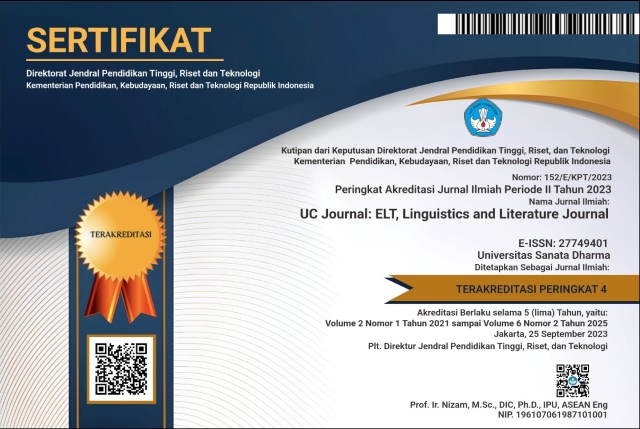STUDY ON ENGLISH LANGUAGE EVALUATION STANDARDS
(1) Mandakh University, Mongolia
(2) Mandakh University
(*) Corresponding Author
Abstract
Keywords
Full Text:
PDFReferences
Alderson, C. J. (2007). The CEFR and the need for more research. The Modern Language Journal, 91(4) 695-663. https://doi.org/10.1111/j.1540-4781.2007.00627_4.x
Barni, M. (2015). In the name of the CEFR: Individuals and standards. In B. Spolsky, O. Inbar-Lourie, & M. Tannenbaum (Eds.), Challenges of language education and policy (pp.40-52). New York: Routledge.
Byram, M., & Parmenter, L. (2012). The common European framework of reference. In M. Byram & L. Parmenter (Eds.), The globalisation of language education policy. Bristol, UK: Multilingual Matters
CEFR. (2018). Common European framework of reference.
Coste, D. (2007). Contextualizing uses of the common European framework of reference for languages, In Council of Europe, The common European framework of references for languages (CEFR) and the development of language policies: Challenge and responsibilities (pp. 40-49). Strasbourg: Council of Europe.
Deygers, B. (2019). The CEFR companion volume: Between research-based policy and policy-based research. Applied Linguistics, 42(1), 186–191. https://doi.org/10.1093/applin/amz024
Europe, C. (2001). Common European framework of reference for languages: Learning, teaching and assessment. Strasborg: Language Policy Unit.
Figueras, N. (2012). The impact of the CEFR. ELT Journal, 66(4), 477-485. https://doi.org/10.1093/elt/ccs037
Fulcher, G. (2004). Deluded by artifices? The common European framework and harmonization. Language Assessment Quarterly, 1(4), 253-266. https://doi.org/10.1207/s15434311laq0104_4
Green, A. (2012). Language functions revisited: Theoretical and empirical bases for language construct definition across the ability range. English Profile Studies, 2. Cambridge: Cambridge University Press.
Hulstijn, J. H. (2007). The shaky ground beneath the CEFR: Quantitative and qualitative dimensions of language proficiency. The Modern Language Journal, 91(4), 663–667. http://www.jstor.org/stable/4626094
Hung, N. N. (2013). Vietnam‘s national foreign language 2020 project: Challenges, opportunities, and solutions. The International Academic Forum, 62-64.
Komorowska, H. (2014). The CEFR in pre- and in-service teacher education. In K, Morrow (Ed.), Insights from the common European framework (pp. 55-64). Oxford: Oxford University Press.
Krumm, H. J. (2007). Profiles instead of levels: The CEFR and its (ab)uses in the context of migration. The Modern Language Journal, 91(4), 667–9. https://doi.org/10.1111/j.1540-4781.2007.00627_6.x
McNamara, T. (2014). 30 years on—Evolution or revolution?. Language Assessment Quarterly, 11(2), 226-232. https://doi.org/10.1080/15434303.2014.895830
Nguyen, V., & Hamid, M. O. (2015). Educational policy borrowing in a globalized world a case study of common European framework of reference for languages in a Vietnamese University. Journal of English Teaching, Practice and Critique, 14(1), 60-74. https://doi.org/10.1108/ETPC-02-2015-0014
North, B. (2004). Europe‘s framework promotes language discussion, not directives.
North, B. O. (2010). A core inventory for general English. London: British Council.
Orosoo, M., & Jamiyansuren, B. (2021). Language in Education planning: Evaluation Policy in Mongolia. Journal of Language and Linguistic studies, 17(3), 1608-1614.
Poszytek, P. (2012). Policy perspectives from Poland. In M. Byram & L. Parmenter (Eds.), The common European framework of reference: The globalization of languageeducation policy (pp. 97-103). Bristol, UK: Multilingual Matters.
Trim, J. (2012). The Common European Framework of Reference for Languages and its background: A case study of cultural politics and educational influences. The Common European Framework of Reference.
Van Ek, J., & Trim, J. L. M. (1990). Threshold Cambridge . Cambridge: Cambridge University.
DOI: https://doi.org/10.24071/uc.v3i2.5365
Refbacks
- There are currently no refbacks.
Copyright (c) 2022 Oyun-Erdene Tumurbat, Namuun Sergelen

This work is licensed under a Creative Commons Attribution-ShareAlike 4.0 International License.
UC Journal is indexed in:
UC Journal Sinta 4 Certificate (S4 = Level 4)
We would like to inform you that UC Journal: ELT, Linguistics and Literature Journal, or UC Journal has been nationally accredited Sinta 4 by the Ministry of Education, Culture, Research and Technology of the Republic of Indonesia based on the decree No. Surat Keputusan 152/E/KPT/2023. Validity for 5 years: Vol 2 No 1, 2021 till Vol 6 No 2, 2025
DOI: https://doi.org/10.24071/uc
e-ISSN (validity starting Vol 1, No 2, November 2020): 2774-9401

This work is licensed under CC BY-SA.
Creative Commons Attribution-ShareAlike 4.0 International License
 UC Journal: ELT, Linguistics and Literature Journal, a scientific peer-reviewed journal, was established in 20 May 2020 and is published twice a year, namely in May and November, by the English Language Education Study Programme (S1/Sarjana PBI) in collaboration with the English Education Master's Programme (S2/Magister PBI) of Sanata Dharma University, Yogyakarta, Indonesia.
UC Journal: ELT, Linguistics and Literature Journal, a scientific peer-reviewed journal, was established in 20 May 2020 and is published twice a year, namely in May and November, by the English Language Education Study Programme (S1/Sarjana PBI) in collaboration with the English Education Master's Programme (S2/Magister PBI) of Sanata Dharma University, Yogyakarta, Indonesia.














